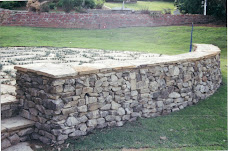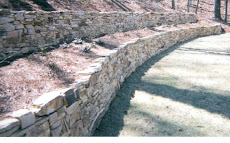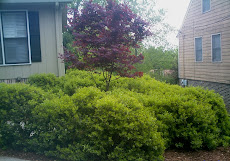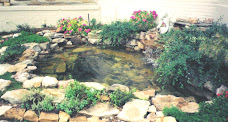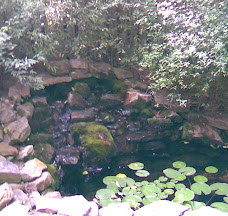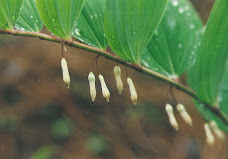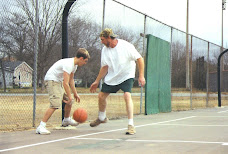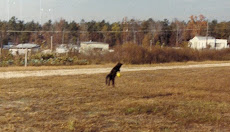
During my recent working trip to Dadeville, I would drive to the local hardware store or corner gas station from time to time. By the way, how great are those old time hardware stores! My little forays to pick up mortar mix or a Diet Mountain Dew would always direct me by a little house off the road with a giant oak tree smack dab in the middle of the front yard. Growing all over its massive branches was this tiny fern...clusters of them, happy and green, a sight to be seen. 
Of course, Resurrection fern is not an oddity in the South (and it does grow as far North as Delaware). If you are out and about and looking for it, you'll probably see the little evergreen fern pretty quickly. Every now and then, you'll likely spot an old Oak tree that is pert near full of them, except for the sunniest parts of the tree. It's really a pretty sight.
Resurrection fern is an epiphyte (air plant) that grows along the narrow cracks and furrows of its host tree's bark, getting nutrients that collect on the outer surface of bark. It is not a parasite, like Mistletoe, and it does not harm or damage the tree it is growing on.
When dry, the resurrection fern is gray, scaly and curled up in a wad, but when moisture returns, the fronds resurrect becoming soft and green and unfurling to regain its original shape. 
If you don't have resurrection fern growning on trees in your yard, you can grab a starter plant from a fallen branch in the woods and squeeze several inches of the fern's rhizome into the furrows of the bark of its new host. Keep it moistened from time to time until it takes hold and begins growing on its own.
ps...thank you, floridata.com for the lovely pics
Saturday, March 29, 2008
Resurrection fern
Posted by
themanfromearth
at
8:28 AM
0
comments
![]()
Labels: evergreen landscape plants
Tuesday, March 18, 2008
Are you considering planting Indian Hawthorne?

PHOTO: Snow White Indian Hawthorne (Raphiolepsis umbellata ‘Snow White’) - White, small clusters; plant grows to about 3.5’ by 3.5’.
My first blog request! And a dandy it is ….. Indian hawthorne (genus Raphiolepsis). Most Indian hawthorne are compact (although I’ve seen some Hawthorns approaching over 20’ tall), spring blooming with fragrance (showy in white or pink tones), evergreen shrub.
My subjective observations on the plant: This plant has slowly grown on me over the years. At first, there was a lack of availability in regard to numbers of and variations of Indian hawthorne varieties. Another thing I noticed that kept me from being keen on this plant is that there seemed to be a lot of under performing hawthornes out there. It has since occurred to me that Indian hawthorne is not one of those plants you dig a skimpy hole for and watch it thrive. You can do that with some easier to grow plants, like dwarf yaupon and Chinese holly, but not so much with Indian hawthorne. For instance, if I were going to plant Indian hawthorne in my front foundation planting bed, I’d probably think about adding some fresh soil (bagged or bulk) to the existing soil. The reasons for this extra soil are: (1) to create a “raised” environment (the grade sloping away from the house and the top of the plant root ball being higher than the surrounding soil) (2) to add organic material to the soil, which you will work into the existing dirt in your bed. Trust me, your hawthorne plants will appreciate the attention. Another reason I believe I've noticed so many poor looking Indian Hawthorns, in the past, is that many of them had leaf spot, and possibly, fire blight. Now, there are Raphiolepsis varieties that are disease resistant, making Indian hawthorne a much more viable choice for your garden.
PHOTO: Indian Princess Indian hawthorne (Raphiolepsis indica ‘Monto’) - Pink flower clusters that fade to white for a two color effect; plant grows about 3’ tall by about 5’ wide.
But wait! I’m getting ahead of myself, here. Will Indian hawthorne grow in the conditions I have awaiting it? Here is the recipe for good Indian hawthorne behavior:
A. Full sun to part shade - Indian Hawthorns appear to do best in full sun, although I have seen some that seemed to get too much sun, perhaps a hot afternoon sun reflecting off a sidewalk or driveway contributing to that bleached out or scorched look I’ve noticed a few times. I would say, in most instances, that 4+ hours of sunlight should be enough to make your plantings happy. Note that there is some discrepancy among nurseries on how much sun they say Raphiolepsis needs, with some stating the plant will grow in full shade. I just haven’t seen that happening and I don’t agree. Sorry big, huge wholesale nursery in South Alabama whose name I won’t mention :-)
B. Well drained, organically rich soil - thus the addition of soil to your planting bed.
C. Living within zone 7 thru 10 - This depends on variety, but you are generally safe if you live within these zone parameters. Here in North Shelby County, we are in the southern part of zone 7, so Indian hawthorne should be able to survive most anything Old Man Winter has to dish out.
D. Planting the variety that makes since for you. There are lots of species and varieties of Raphiolepsis, so I suggest you read the label carefully when buying an Indian hawthorne. Look for a type that is disease resistant, since Indian hawthornes can get leaf spot. Here are a few disease resistant varieties - Olivia, Gulf Green, Indian Princess, Snow White, Majestic Beauty, Janice, Eleanor Tabor, Jack Evans and Rosalinda. . Check and make sure the hardiness rating includes zone 7 (assuming you live in the Birmingham area) and see what size the plant you are considering will grow to. If you chose a smaller growing, compact variety, you’ll likely have little or no pruning to do for years to come. 
PHOTO: Majestic Beauty Indian hawthorne (Raphiolepsis X ‘Montic’) - Pink, star shaped flowers in huge clusters; plant can grow to 15’+ tall by 12’+ wide.
PHOTO: Eleanor Tabor Indian hawthorne (Raphiolepsis umbellata ‘Conor’) - Pink, small clusters; plant grows to about 3.5’ by 3.5’.
Posted by
themanfromearth
at
11:06 PM
82
comments
![]()
Sunday, March 16, 2008
Lafitte, Louisiana (flora and fishing)

In the swamps of Lafitte there is lots to look at and talk about. Gators and insects and plant life abound. One such plant is the Salt Marsh Mallow (Malva sylvestris). This native plant has become more evident in the swamps due to the loss of larger trees during Katrina.
More interesting, though, are the shenanigans of two fishermen that recently graced the tiny town of Lafitte, Louisiana. From their last resort, overnight stay at a bed and breakfast that caters to newly wed couples to a nice haul of red fish, it seems my dad and brother made a serious impression on this Cajun town. For an in depth report on the fishing trip, go to: http://lafittefishing.com/ (click on fishing report and read the March 15 entry). 
Posted by
themanfromearth
at
10:41 AM
4
comments
![]()
Labels: Recommended Quick Trips, Rob's musings
Friday, March 14, 2008
Job Walk Through
Recently, I undertook a project in Dadeville, AL. My clients wanted me to convert an existing rock patio into a more appealing and usable patio area. The design I presented included a kidney shaped patio, a 15'+ moss rock sitting wall w/ flagstone coping, and a fire pit (raised and also with moss rock and flag coping). We also decided to rebuild/enlarge an existing small pond and water course that is within just a few feet of the patio. You are welcomed to take a tour of this job with me, if you like. Here we go!
This is a before picture. The existing patio was there long before my clients bought the house and, as you can see, it was very uneven and practically unusable.
The first thing I did was bringing a mini-excavator to the job. That machine helped pull out all the stones from the old patio, as well as digging a foundation for the sitting wall/fire pit and leveling the patio area. The blue tarp was my way of working even when it was raining.
Once the mini-excavator work was done, it was good ol' pick, shovel and rake time to complete the fine grading. I had to start work on the sitting wall and the fire pit before getting involved with the patio construction, as well. 
With the sitting wall and fire pit in progress, I installed a crush and run gravel base for the patio, which I compacted with a plate compacter.
This is the stone patio with out grouting....Using the stone from the old patio presented some challenges because a lot of the stone was not very flat and the thickness of the stone varied from 1 inch to 5 inches. 
More stone patio installation before grouting....The reason for using the stone that was already there as opposed to simply getting new flagstone was that, despite the difficulties I've already described, this stone was very pretty stone.
Here's a shot of the project nearly done. The sitting wall w/flagstone coping is completed and the fire pit is also done. Just a little bit more grout work before the patio project is complete.
I encountered all kinds of weather while working on this job. Did I mention it snowed down there?
The finished product!
Here is the pond redo. I pulled up all the rocks and replaced the liner of the old pond, and then redesigned, installed and enlarged. You can left click on the any of the pictures on the right side of my blog to get a closer look. 
View from a room!
Posted by
themanfromearth
at
10:07 PM
2
comments
![]()
Labels: fire pit, patios and walkways, ponds, project showcases, stone work
Saturday, March 8, 2008
What's fun about being a landscaper?
 A waterfall I designed and built about 6 years ago in North Shelby County
A waterfall I designed and built about 6 years ago in North Shelby County
I spent lots of time at the creek near our home, in Homewood, Alabama, when I was growing up and my mom can attest to the fact that I came home very wet and dirty on many an occasion, so it's sort of fitting that I've chosen to make working with dirt, stone, water, etc., my vocation. Not that I am the only guy that got dirty playing in a creek as a little boy, but I will say I was REALLY into the creek!...just kidding...no more than most kids.
One of the main reasons I enjoy being a small landscape contractor (really small, as in often a one man operation), is that I get to be creative. I know there are mega companies out there that can install 20 ton boulders and 10 inch caliper trees, and have multiple corporate size projects going at one time. That's not me, but I'm quite happy doing what I do, working closely with my clients and developing some friendships along the way. I know lots of people that truly enjoy what they do for a living and I'm right in there with them. At a time when we are all hearing from the political pundits about what's wrong with America, I'd like to think there are lots of folks out there that are also feeling blessed for what ever they have.
Posted by
themanfromearth
at
9:47 PM
1 comments
![]()
Labels: ponds, Rob's musings
Sunday, March 2, 2008
Pansy Tip
Here is my take on pansies here in Alabama.
We plant them in the fall or early winter because we know they like cool weather. Also, after the first freeze, there is no other annual that performs as well as pansies do.
It is now early March and there is no better time for your existing pansies to look their best. There are several reasons for this. One reason is that our lowest low temps aren't nearly as tough on pansies in March as they are in January/February. Every time we get down into the twenties or teens, pansies take a bit of a hit and take a little time to recover, even though they like cool weather. Teen temps won't typically kill a pansy plant, but you aren't going to see them going full steam ahead when it's that cold, either. Another big reason your existing pansy beds can do so well, right now, is because the root system is more developed because they've been growing for several months. Nice cool, but not cold, weather, coupled with a mature root system are setting your pansies up for success. To reap the benefits, you need to do three things to make it happen for you:
1. dead head your pansy plants (remove spent blooms)
2. fertilize with a plant food formulated for blooming annuals
3. make sure your pansies beds don't get too dry (water 2 x's a week inbetween rains)
The last month or so of pansy season can be a full color blast!
Posted by
themanfromearth
at
11:01 PM
0
comments
![]()
Labels: landscape tip





